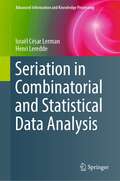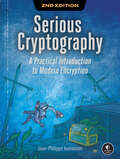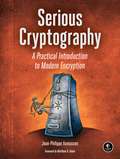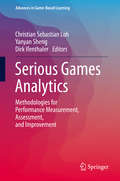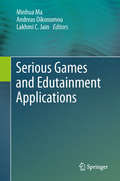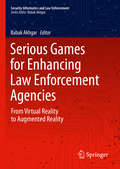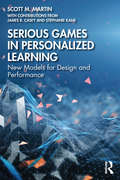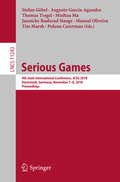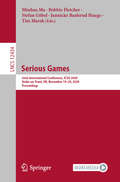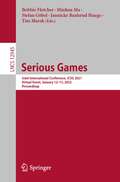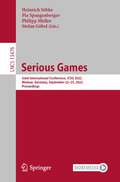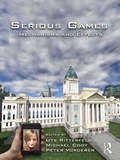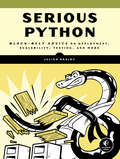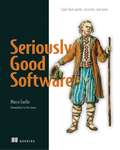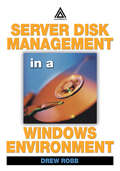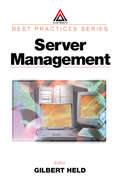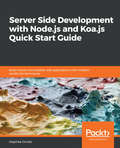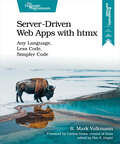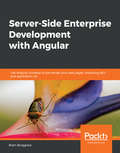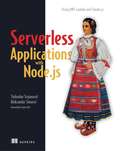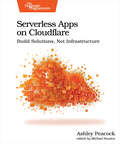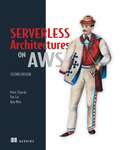- Table View
- List View
Seriation in Combinatorial and Statistical Data Analysis (Advanced Information and Knowledge Processing)
by Israël César Lerman Henri LereddeThis monograph offers an original broad and very diverse exploration of the seriation domain in data analysis, together with building a specific relation to clustering.Relative to a data table crossing a set of objects and a set of descriptive attributes, the search for orders which correspond respectively to these two sets is formalized mathematically and statistically. State-of-the-art methods are created and compared with classical methods and a thorough understanding of the mutual relationships between these methods is clearly expressed. The authors distinguish two families of methods:Geometric representation methodsAlgorithmic and Combinatorial methods Original and accurate methods are provided in the framework for both families. Their basis and comparison is made on both theoretical and experimental levels. The experimental analysis is very varied and very comprehensive. Seriation in Combinatorial and Statistical Data Analysis has a unique character in the literature falling within the fields of Data Analysis, Data Mining and Knowledge Discovery. It will be a valuable resource for students and researchers in the latter fields.
Serious Cryptography, 2nd Edition: A Practical Introduction to Modern Encryption
by Jean-Philippe AumassonCrypto can be cryptic. Serious Cryptography, 2nd Edition arms you with the tools you need to pave the way to understanding modern crypto.This thoroughly revised and updated edition of the bestselling introduction to modern cryptography breaks down fundamental mathematical concepts without shying away from meaty discussions of how they work. In this practical guide, you&’ll gain immeasurable insight into topics like authenticated encryption, secure randomness, hash functions, block ciphers, and public-key techniques such as RSA and elliptic curve cryptography.You&’ll find coverage of topics like:The basics of computational security, attacker models, and forward secrecyThe strengths and limitations of the TLS protocol behind HTTPS secure websitesQuantum computation and post-quantum cryptographyHow algorithms like AES, ECDSA, Ed25519, Salsa20, and SHA-3 workAdvanced techniques like multisignatures, threshold signing, and zero-knowledge proofsEach chapter includes a discussion of common implementation mistakes using real-world examples and details what could go wrong and how to avoid these pitfalls. And, true to form, you&’ll get just enough math to show you how the algorithms work so that you can understand what makes a particular solution effective—and how they break. NEW TO THIS EDITION: This second edition has been thoroughly updated to reflect the latest developments in cryptography. You&’ll also find a completely new chapter covering the cryptographic protocols in cryptocurrency and blockchain systems.Whether you&’re a seasoned practitioner or a beginner looking to dive into the field, Serious Cryptography will demystify this often intimidating topic. You&’ll grow to understand modern encryption and its applications so that you can make better decisions about what to implement, when, and how.
Serious Cryptography: A Practical Introduction to Modern Encryption
by Jean-Philippe AumassonThis practical guide to modern encryption breaks down the fundamental mathematical concepts at the heart of cryptography without shying away from meaty discussions of how they work. You’ll learn about authenticated encryption, secure randomness, hash functions, block ciphers, and public-key techniques such as RSA and elliptic curve cryptography.You’ll also learn: - Key concepts in cryptography, such as computational security, attacker models, and forward secrecy - The strengths and limitations of the TLS protocol behind HTTPS secure websites - Quantum computation and post-quantum cryptography - About various vulnerabilities by examining numerous code examples and use cases - How to choose the best algorithm or protocol and ask vendors the right questionsEach chapter includes a discussion of common implementation mistakes using real-world examples and details what could go wrong and how to avoid these pitfalls. Whether you’re a seasoned practitioner or a beginner looking to dive into the field, Serious Cryptography will provide a complete survey of modern encryption and its applications.
Serious Games Analytics
by Dirk Ifenthaler Christian Sebastian Loh Yanyan ShengThis volume brings together research on how gameplay data in serious games may be turned into valuable analytics or actionable intelligence for performance measurement, assessment, and improvement. Chapter authors use empirical research methodologies, including existing, experimental, and emerging conceptual frameworks, from various fields, such as: computer science software engineering educational data mining statistics information visualization. Serious games is an emerging field where the games are created using sound learning theories and instructional design principles to maximize learning and training success. But how would stakeholders know what play-learners have done in the game environment, and if the actions performance brings about learning? Could they be playing the game for fun, really learning with evidence of performance improvement, or simply gaming the system, i. e. , finding loopholes to fake that they are making progress? This volume endeavors to answer these questions.
Serious Games and Edutainment Applications
by Lakhmi C. Jain Andreas Oikonomou Minhua MaThe recent re-emergence of serious games as a branch of video games and as a promising frontier of education has introduced the concept of games designed for a serious purpose other than pure entertainment. To date the major applications of serious games include education and training, engineering, medicine and healthcare, military applications, city planning, production, crisis response, to name just a few. If utilised alongside, or combined with conventional training and educational approaches, serious games could provide a more powerful means of knowledge transfer in almost every application domain. Serious Games and Edutainment Applications offers an insightful introduction to the development and applications of games technologies in educational settings. It includes cutting-edge academic research and industry updates that will inform readers of current and future advances in the area. The book is suitable for both researchers and educators who are interested in using games for educational purposes, as well as game professionals requiring a thorough understanding of issues involved in the application of video games technology into educational settings. It is also applicable to programmers, game artists, and management contemplating or involved in the development of serious games for educational or training purposes.
Serious Games and Edutainment Applications: Volume Ii
by Lakhmi C. Jain Andreas Oikonomou Minhua MaThe recent re-emergence of serious games as a branch of video games and as a promising frontier of education has introduced the concept of games designed for a serious purpose other than pure entertainment. To date the major applications of serious games include education and training, engineering, medicine and healthcare, military applications, city planning, production, crisis response, to name just a few. If utilised alongside, or combined with conventional training and educational approaches, serious games could provide a more powerful means of knowledge transfer in almost every application domain. Serious Games and Edutainment Applications offers an insightful introduction to the development and applications of games technologies in educational settings. It includes cutting-edge academic research and industry updates that will inform readers of current and future advances in the area. The book is suitable for both researchers and educators who are interested in using games for educational purposes, as well as game professionals requiring a thorough understanding of issues involved in the application of video games technology into educational settings. It is also applicable to programmers, game artists, and management contemplating or involved in the development of serious games for educational or training purposes.
Serious Games for Enhancing Law Enforcement Agencies: From Virtual Reality to Augmented Reality (Security Informatics and Law Enforcement)
by Babak AkhgarThis book provides a comprehensive and practically minded introduction into serious games for law enforcement agencies. Serious games offer wide ranging benefits for law enforcement with applications from professional trainings to command-level decision making to the preparation for crises events. This book explains the conceptual foundations of virtual and augmented reality, gamification and simulation. It further offers practical guidance on the process of serious games development from user requirements elicitation to evaluation. The chapters are intended to provide principles, as well as hands-on knowledge to plan, design, test and apply serious games successfully in a law enforcement environment. A diverse set of case studies showcases the enormous variety that is possible in serious game designs and application areas and offers insights into concrete design decisions, design processes, benefits and challenges. The book is meant for law enforcement professionals interested in commissioning their own serious games as well as game designers interested in collaborative pedagogy and serious games for the law enforcement and security sector.
Serious Games in Personalized Learning: New Models for Design and Performance
by Stephanie Kane Scott M. Martin James R. CaseySerious Games in Personalized Learning investigates game-based teaching and learning at a time when learning and training systems are increasingly integrating serious games, machine-learning artificial intelligence models, and adaptive technologies. Game-based education provides rare data for measuring, assessing, and evaluating not just a game’s effectiveness but the acquisition of information and knowledge that a student may gain through playing a learning game. This book synthesizes contemporary research, frameworks, and models centered on the design and delivery of serious games that truly personalize the learning experience. Scholars of educational technology, instructional design, human performance, and more will find a comprehensive guide to the history, practical implications, and data-collection potential inherent to these fast-evolving tools.
Serious Games: 10th Joint International Conference, JCSG 2024, New York City, NY, USA, November 7–8, 2024, Proceedings (Lecture Notes in Computer Science #15259)
by Jan L. Plass Xavier OchoaThis book constitutes the refereed proceedings of the 10th Joint International Conference on Serious Games, JCSG 2024, held in New York City, NY, USA, during November 7–8, 2024. The 19 full papers, 5 short papers, 12 posters and 5 demos included in this book were carefully reviewed and selected from 63 submissions. They were organized in topical sections as follows: Artificial intelligence in serious games; Serious games analytics; Serious game design; Impact studies; Extended realities; Healthcare and wellbeing; Applications.
Serious Games: 4th Joint International Conference, Jcsg 2018, Darmstadt, Germany, November 7-8, 2018. Proceedings (Lecture Notes in Computer Science #11243)
by Minhua Ma Tim Marsh Stefan Göbel Jannicke Baalsrud Hauge Augusto Garcia-Agundez Thomas Tregel Manuel Oliveira Polona CasermanThis book constitutes the proceedings of the 4th International Conference on Serious Games, JCSG 2018, held in Darmstadt, Germany, in November 2018. The 15 full and 12 short papers presented in this volume were carefully reviewed and selected from 40 submissions. They were organized in topical sections named: serious games studies; game-based learning and teaching; game development - serious games design, models, tools and emerging technologies; and serious games for health.
Serious Games: 9th Joint International Conference, JCSG 2023, Dublin, Ireland, October 26–27, 2023, Proceedings (Lecture Notes in Computer Science #14309)
by Stefan Göbel Mads Haahr Alberto Rojas-SalazarThis book constitutes the refereed proceedings of the 9th Joint International Conference on Serious Games, JCSG 2023, held in Dublin, Ireland, during October 26–27, 2023. The 18 full papers presented together with 9 short papers and 14 poster papers were carefully reviewed and selected from 53 submissions. They are grouped into the following topics: technology and systems; theoretical and design aspects; health and wellbeing; extended realities; soft and social skills; academic skills; and posters and exhibits.
Serious Games: Joint International Conference, JCSG 2020, Stoke-on-Trent, UK, November 19–20, 2020, Proceedings (Lecture Notes in Computer Science #12434)
by Minhua Ma Tim Marsh Stefan Göbel Jannicke Baalsrud Hauge Bobbie FletcherThis book constitutes the refereed proceedings of the 6th Joint International Conference on Serious Games, JCSG 2020, held in Stoke-on-Trent, UK, in November 2020. The 19 full papers presented together with 3 short papers were carefully reviewed and selected from 38 submissions. The papers offer a wide range in the use of serious games in several fields like learning, simulation, training, health, well-being, management, assessment or marketing and much more.
Serious Games: Joint International Conference, JCSG 2021, Virtual Event, January 12–13, 2022, Proceedings (Lecture Notes in Computer Science #12945)
by Minhua Ma Tim Marsh Stefan Göbel Jannicke Baalsrud Hauge Bobbie FletcherThis book constitutes the refereed proceedings of the 7th Joint International Conference on Serious Games, JCSG 2021, as virtual event, in January 2022.The 17 full papers presented together with 3 short papers were carefully reviewed and selected from 28 submissions. JSCG 2021 is dedicated to serious games and its interdisciplinary characteristics combining game concepts and technologies required in the different application domains.
Serious Games: Joint International Conference, JCSG 2022, Weimar, Germany, September 22–23, 2022, Proceedings (Lecture Notes in Computer Science #13476)
by Stefan Göbel Philipp Müller Heinrich Söbke Pia SpangenbergerThis book constitutes the refereed proceedings of the 8th Joint International Conference on Serious Games, JCSG 2022, held in Weimar, Germany, in September 2022. The 14 full papers presented together with 5 short papers were carefully reviewed and selected from 31 submissions. JSCG 2022 is dedicated to serious games and its interdisciplinary characteristics combining game concepts and technologies required in the different application domains. This year’s proceedings are categorized into the following topical sub-headings: Learning Psychology, Design Aspects, Game Design, Health Games, Games Application, and Mixed Reality.
Serious Games: Mechanisms and Effects
by Michael Peter Vorderer Ritterfeld Ute CodySerious Games provides a thorough exploration of the claim that playing games can provide learning that is deep, sustained and transferable to the real world. "Serious games" is defined herein as any form of interactive computer-based game software for one or multiple players to be used on any platform and that has been developed to provide more than entertainment to players. With this volume, the editors address the gap in exisiting scholarship on gaming, providing an academic overview on the mechanisms and effects of serious games. Contributors investigate the psychological mechanisms that take place not only during gaming, but also in game selection, persistent play, and gaming impact. The work in this collection focuses on the desirable outcomes of digital game play. The editors distinguish between three possible effects -- learning, development, and change -- covering a broad range of serious games’ potential impact. Contributions from internationally recognized scholars focus on five objectives: Define the area of serious games Elaborate on the underlying theories that explain suggested psychological mechanisms elicited through serious game play, addressing cognitive, affective and social processes Summarize the empirical evidence on the effectiveness of serious games, Introduce innovative research methods as a response to methodological challenges imposed through interactive media Discuss the possibilities and limitations of selected applications for educational purposes. Anchored primarily in social science research, the reader will be introduced to approaches that focus on the gaming process and the users’ experiences. Additional perspectives will be provided in the concluding chapters, written from non-social science approaches by experts in academic game design and representatives of the gaming industry. The editors acknowledge the necessity for a broader interdisciplinary study of the phenomena and work to overcome the methodological divide in games research to look ahead to a more integrated and interdisciplinary study of digital games. This timely and singular volume will appeal to scholars, researchers, and graduate students working in media entertainment and game studies in the areas of education, media, communication, and psychology.
Serious Python: Black-Belt Advice on Deployment, Scalability, Testing, and More
by Julien DanjouAn indispensable collection of practical tips and real-world advice for tackling common Python problems and taking your code to the next level. Features interviews with high-profile Python developers who share their tips, tricks, best practices, and real-world advice gleaned from years of experience.Sharpen your Python skills as you dive deep into the Python programming language with Serious Python. You'll cover a range of advanced topics like multithreading and memorization, get advice from experts on things like designing APIs and dealing with databases, and learn Python internals to help you gain a deeper understanding of the language itself. Written for developers and experienced programmers, Serious Python brings together over 15 years of Python experience to teach you how to avoid common mistakes, write code more efficiently, and build better programs in less time. As you make your way through the book's extensive tutorials, you'll learn how to start a project and tackle topics like versioning, layouts, coding style, and automated checks. You'll learn how to package your software for distribution, optimize performance, use the right data structures, define functions efficiently, pick the right libraries, build future-proof programs, and optimize your programs down to the bytecode. You'll also learn how to: - Make and use effective decorators and methods, including abstract, static, and class methods- Employ Python for functional programming using generators, pure functions, and functional functions- Extend flake8 to work with the abstract syntax tree (AST) to introduce more sophisticated automatic checks into your programs- Apply dynamic performance analysis to identify bottlenecks in your code- Work with relational databases and effectively manage and stream data with PostgreSQLIf you've been looking for a way to take your Python skills from good to great, Serious Python will help you get there. Learn from the experts and get seriously good at Python with Serious Python!
Seriously Good Software: Code that works, survives, and wins
by Marco FaellaSummary Serious developers know that code can always be improved. With each iteration, you make optimizations—small and large—that can have a huge impact on your application&’s speed, size, resilience, and maintainability. In Seriously Good Software: Code that Works, Survives, and Wins, author, teacher, and Java expert Marco Faella teaches you techniques for writing better code. You&’ll start with a simple application and follow it through seven careful refactorings, each designed to explore another dimension of quality. Purchase of the print book includes a free eBook in PDF, Kindle, and ePub formats from Manning Publications. About the technology Great code blends the skill of a programmer with the time-tested techniques and best practices embraced by the entire development community. Although each application has its own context and character, some dimensions of quality are always important. This book concentrates on seven pillars of seriously good software: speed, memory usage, reliability, readability, thread safety, generality, and elegance. The Java-based examples demonstrate techniques that apply to any OO language. About the book Seriously Good Software is a handbook for any professional developer serious about improving application quality. It explores fundamental dimensions of code quality by enhancing a simple implementation into a robust, professional-quality application. Questions, exercises, and Java-based examples ensure you&’ll get a firm grasp of the concepts as you go. When you finish the last version of the book&’s central project, you&’ll be able to confidently choose the right optimizations for your code. What's inside Evaluating software qualities Assessing trade-offs and interactions Fulfilling different objectives in a single task Java-based exercises you can apply in any OO language About the reader For developers with basic object-oriented programming skills and intermediate Java skills. About the author Marco Faella teaches advanced programming at a major Italian university. His published work includes peer-reviewed research articles, a Java certification manual, and a video course. Table of Contents *Part 1: Preliminaries * 1 Software qualities and a problem to solve 2 Reference implementation *Part 2: Software Qualities* 3 Need for speed: Time efficiency 4 Precious memory: Space efficiency 5 Self-conscious code: Reliability through monitoring 6 Lie to me: Reliability through testing 7 Coding aloud: Readability 8 Many cooks in the kitchen: Thread safety 9 Please recycle: Reusability
Server Disk Management in a Windows Environment
by Drew RobbHard drives and disk management receive scant attention from the industry press, yet recent surveys have identified disk failure as the #1 source of server downtime. Combine this fact with the skyrocketing TCO of data storage management, and it is apparent that server disk management is a subject deserving of much more scrutiny.Server Disk
Server Management (Best Practices)
by Gilbert HeldThis single-volume desktop reference provides comprehensive information on all server issues - featuring contributions from experts in the field. Engineers for system vendors, systems integrators, major resellers, end-users, and representatives from Hewlett-Packard, Novell, IBM, Compaq, Microsoft, and NEC share their ideas and experience on such to
Server Side development with Node.js and Koa.js Quick Start Guide: Build robust and scalable web applications with modern JavaScript techniques
by Olayinka OmoleBuild real-world robust web applications and APIs using the modern and expressive Koa Node.js framework.Key FeaturesGet up and running with Koa.js and leverage its power with node.jsGet the most out of Koa Async functions and generatorsCreate real time dynamic serverside apps efficiently with Koa.js Book DescriptionEvery developer wants to build modular and scalable web applications. Modern versions of JavaScript have made this possible in Node.js, and Koa is a Node.js framework that makes it easy. This book is the ideal introduction for JavaScript developers who want to create scalable server side applications using Node.js and Koa.js.The book shows you how Koa can be used to start projects from scratch, register custom and existing middleware, read requests, and send responses to users. We will explore the core concepts in Koa, such as error handling, logging, and request and response handling. We will dive into new concepts in JavaScript development, and see how paradigms such as async/await help with modern Node.js application development.By the end of this book, you will be building robust web applications in Koa using modern development paradigms and techniques of Node.js development.What you will learnCreate a simple server in Node.js and KoaWork with custom middleware in KoaHandle errors in KoaCreate routes, handle requests, and send responses from APIsBuild views and use templates in KoaAuthenticate your application and structure it properly in KoaWho this book is forThis book is for serverside developers and JavaScript developers who want to use Koa.js and Node.js to create fast and real time back end applications.
Server-Driven Web Apps with htmx
by R. Mark Volkmannhtmx is a library that adds logic and server interaction to HTML; you get the effect of using a front-end SPA framework without writing front-end code. Use any server-side programming language and framework to build server applications with endpoints that simply return snippets of HTML. Dynamically update portions of the current web page from HTTP responses. Add interactivity with JavaScript and libraries such Alpine and _hyperscript. Make your apps more secure by escaping user-supplied content and specifying a Content Security Policy. Go beyond basic HTTP requests with WebSockets and server-sent events. The htmx JavaScript library gives you a new way to craft web applications. The htmx approach differs significantly from that of the currently popular single-page application (SPA) frameworks; rather than write a bunch of JavaScript, you simply annotate HTML elements before you send them to the browser. The resulting code is easier to understand and modify, and because it downloads less to the browser and doesn't need JSON creation and parsing, you'll find it performs better, too. Rethink web application design; write code in any language that simply responds to requests with htmx snippets.Dynamically update portions of the current web page directly from the server.Implement common patterns such as lazy loading, input validation, CSS transitions, active search, optimistic updates, pagination, infinite scroll, polling, and click-to-edit.Add interactivity with JavaScript and libraries such as Alpine and _hyperscript.Use the htmx JavaScript API to simplify DOM operations.Make your web apps more secure: escape user-supplied content, use Subresource Integrity hashes, and enforce a Content Security Policy.Go beyond the basic HTTP request/response pattern with WebSockets and server-sent events.Discover a simpler way to implement web applications that emphasizes web fundamentals.What You Need:A modern web browser and the ability to build and run a local HTTP server using the server-side language and framework of your choice.The code examples are fully compatible with htmx 2.0.
Server-Side Development with Angular: Use Angular Universal to pre-render your web pages, improving SEO and application UX
by Bram BorggreveThis book is ideal for experienced front-end developers who are looking to quickly work through an intelligent example that demonstrates all the key features of server-side development with Angular. You'll need some prior exposure to Angular, as we skim over the basics and get straight to work.
Serverless Applications with Node.js: Using AWS Lambda and Claudia.js
by Slobodan Stojanovic Aleksandar SimovicSummaryServerless Applications with Node.js walks you through building serverless apps on AWS using JavaScript. Inside, you'll discover what Claudia.js brings to the table as you build and deploy a scalable event-based serverless application, based around a pizzeria that's fully integrated with AWS services, including Lambda and API Gateway. Each chapter is filled with exercises, examples, tips, and more to make sure you're ready to bring what you've learned into your own work.Foreword by Gojko Adzic.Purchase of the print book includes a free eBook in PDF, Kindle, and ePub formats from Manning Publications.About the TechnologyThe benefits of cloud-hosted serverless web apps are undeniable: lower complexity, quicker time to market, and easier scalability than traditional, server-dependent designs. And thanks to JavaScript support in AWS Lambda and powerful new serverless API tools like the Claudia.js library, you can build and deploy serverless apps end to end without learning a new language.About the BookServerless Applications with Node.js teaches you to design and build serverless web apps on AWS using JavaScript, Node, and Claudia.js. You'll master the basics of writing AWS Lambda functions, along with core serverless patterns like API Gateway. Along the way, you'll practice your new skills by building a working chatbot and a voice assistant with Amazon Alexa. You'll also discover techniques for migrating existing apps to a serverless platform.What's insideAuthentication and database storageAsynchronous functionsInteresting real-world examplesDeveloping serverless microservicesAbout the ReaderFor web developers comfortable with JavaScript and Node.js.About the AuthorSlobodan Stojanović and Aleksandar Simović are AWS Serverless Heroes and core contributors to the Claudia.js project. They are also coauthors of Desole, an open source serverless errortracking tool, and the lead developers of Claudia Bot Builder.Table of ContentsPART 1 - Serverless pizzeriaIntroduction to serverless with ClaudiaBuilding your first serverless APIAsynchronous work is easy, we Promise()Pizza delivery: Connecting an external serviceHouston, we have a problem!Level up your APIWorking with filesPART 2 - Let's talkWhen pizza is one message away: ChatbotsTyping... Async and delayed responsesJarvis, I mean Alexa, order me a pizzaPaying for pizzaMigrating to serverlessReal-world case studiesappendix A - Installation and configurationappendix B - Facebook Messenger, Twilio, and Alexa configurationappendix C - Stripe and MongoDB setupappendix D - The pizza recipe
Serverless Apps on Cloudflare
by Ashley PeacockUse serverless technologies to build applications that scale, more quickly and easily, and without worrying about deployment. Whether you're writing an API, a full-stack app, or real-time code, harness the power of serverless on Cloudflare's platform so you can focus on what you do best: delivering solutions. With hands-on instruction and code samples throughout, you'll go from building a simple API to analyzing images with AI. And, when it's time to launch, you'll learn how to deploy your applications and websites automatically, and how to optimize their performance for production. For decades, applications have been built and deployed in a similar way: you write code, provision a server, and upload your code. Over the years, you've graduated from FTP or SSH to Docker and Kubernetes, but fundamentally you've just switched from owning to renting; you're paying 24/7 for the server hosting your app. Serverless technologies change that model. With serverless, you focus on writing code, and not how it's deployed. You only pay for when your application code is executed, rather than paying for idle servers. In this book we'll use Cloudflare, which was built from the ground up to be a serverless platform, but the same concepts apply to every serverless provider. With this book, you'll learn a better way to build applications, and you'll see improved productivity and ease of deployment. From secrets to dependencies, such as databases and caches, Cloudflare has revolutionized how to build applications, and has made building applications easier and more fun. As you go through the book, you'll learn in detail what serverless is, how it functions behind the scenes, and how to build serverless applications on Cloudflare. When you finish this book, you'll understand how to think in terms of serverless functions, and you'll have the experience of deploying and extending these apps as you work through the examples. What You Need: Mac or PCGitHub account (free)Cloudflare account (free)
Serverless Architectures on AWS, Second Edition
by Yan Cui Peter Sbarski Ajay NairDesign low-maintenance systems using pre-built cloud services! Bring down costs, automate time-consuming ops tasks, and scale on demand.In Serverless Architectures on AWS, Second Edition you will learn: First steps with serverless computing The principles of serverless design Important patterns and architectures How successfully companies have implemented serverless Real-world architectures and their tradeoffs Serverless Architectures on AWS, Second Edition teaches you how to design serverless systems. You&’ll discover the principles behind serverless architectures, and explore real-world case studies where companies used serverless architectures for their products. You won&’t just master the technical essentials—the book contains extensive coverage of balancing tradeoffs and making essential technical decisions. This new edition has been fully updated with new chapters covering current best practice, example architectures, and full coverage of the latest changes to AWS. About the technology Maintaining server hardware and software can cost a lot of time and money. Unlike traditional data center infrastructure, serverless architectures offload core tasks like data storage and hardware management to pre-built cloud services. Better yet, you can combine your own custom AWS Lambda functions with other serverless services to create features that automatically start and scale on demand, reduce hosting cost, and simplify maintenance. About the book In Serverless Architectures with AWS, Second Edition you&’ll learn how to design serverless systems using Lambda and other services on the AWS platform. You&’ll explore event-driven computing and discover how others have used serverless designs successfully. This new edition offers real-world use cases and practical insights from several large-scale serverless systems. Chapters on innovative serverless design patterns and architectures will help you become a complete cloud professional. What's inside First steps with serverless computing The principles of serverless design Important patterns and architectures Real-world architectures and their tradeoffs About the reader For server-side and full-stack software developers. About the author Peter Sbarski is VP of Education and Research at A Cloud Guru. Yan Cui is an independent AWS consultant and educator. Ajay Nair is one of the founding members of the AWS Lambda team. Table of Contents PART 1 FIRST STEPS 1 Going serverless 2 First steps to serverless 3 Architectures and patterns PART 2 USE CASES 4 Yubl: Architecture highlights, lessons learned 5 A Cloud Guru: Architecture highlights, lessons learned 6 Yle: Architecture highlights, lessons learned PART 3 PRACTICUM 7 Building a scheduling service for ad hoc tasks 8 Architecting serverless parallel computing 9 Code Developer University PART 4 THE FUTURE 10 Blackbelt Lambda 11 Emerging practices
